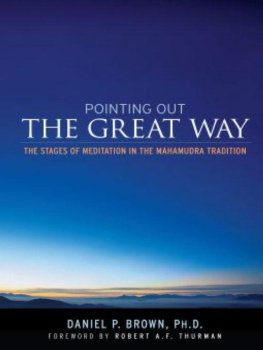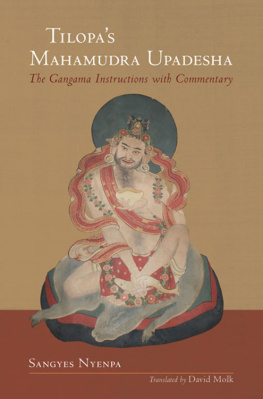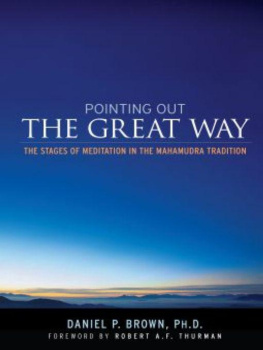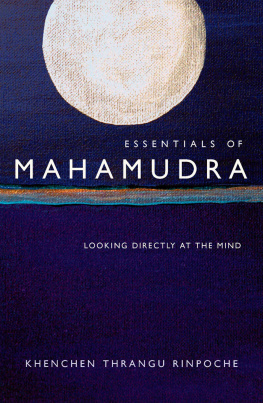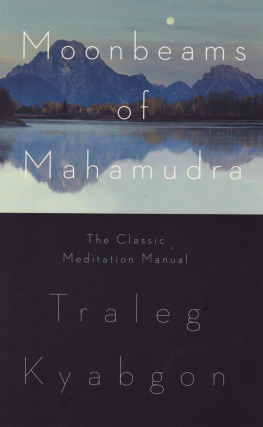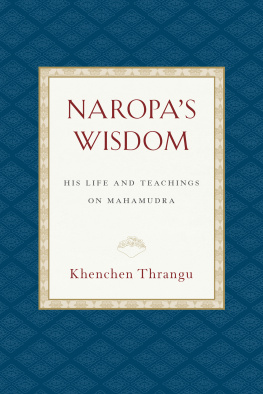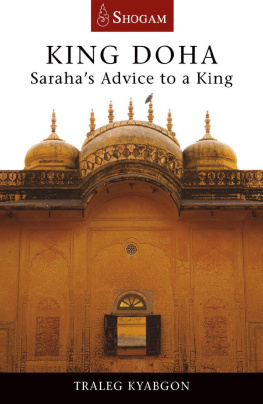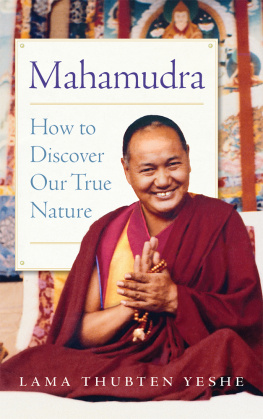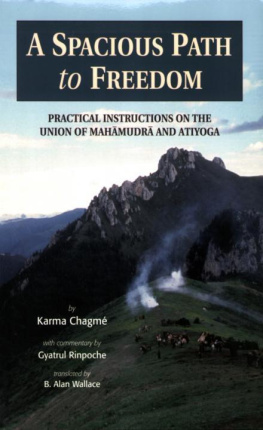Table of Contents
List of Tables
FOREWORD
I am pleased and honored to write a brief foreword to Dan Browns marvelous Pointing Out the Great Way, a spiritual manual, meditation instruction, psychological study, and cross-cultural bridge. I am sure all his gurus and teachers are delighted that his many years of study and practice of Tibetan and Indian Buddhist meditation, and his almost as many years of psychotherapeutic practice and research, have come to this extraordinary sharing of his garnered wisdom in a true pointing-out spiritual instruction for our times.
The Sanskrit mahmudr (Tibetan, phyag rgya chen po ) literally means great seal or great gesture or, somewhat esoterically, great consort, or, most esoterically, great embrace. Mahmudr is a description of the most profound, ultimate, absolute reality that is otherwise called nirva, emptiness-compassion-womb, bliss-void-indivisible, clear-light relativity, buddhahood, truth realm, reality body, nonduality. Mahmudr conveys in its own context the Buddhas foundational discovery that reality, when it is mentally and viscerally, intellectually and experientially known as it truly is, is perfect freedom, infinite life, omnicompetent love and compassion, bliss. All paths of study, reasoning, ethics, and meditative practice taught by Buddha intend to provide usbeings who unrealistically take this bliss-freedom-indivisible reality as a realm of conflict, isolation, and fearwith appropriate paths to become more realistic and thereby discover the all-pervasive freedom and happiness that is really ours. The path of mahmudr, as this pointing-out book abundantly and lucidly explains, is the most immediate and unexcelled of all such paths. It is given the name of the ultimate goal, great embrace, because it proceeds directly to the tender reality of blessed release; in all aspects of space and time, it perceives our existence as nondually and blissfully embraced in absolute freedom. Our extraordinary happiness automatically overflows as glorious love and compassion for all other beings, who are seen swimming with us in the ocean of luminosity.
Even though this supreme path is unexcelled, the teachers in the tradition have voluminous experience in dealing with all different kinds of human beings in various societies and levels of societies. They are fully aware that very few will be helped by such quintessential teaching alone, beyond perhaps a brief moment of hopeful ease upon first hearing about such a nature of reality and such a potential fulfillment in enlightenment of their own love and wisdom. Thus, those great teachers have developed a systematic path of preliminaries, clearly described developmental stages, potential pitfalls and troublesome detours, and various points of entry. These are drawn from chronicles of actual practitioners, from their failures and successes. So there is a way of entry and a plan of evolution to suit almost any kind of person, and in addition most of the writings are meant to be tailored for transmission within unique teacher-student relationships.
Dan Brown has thoroughly investigated and experimented with the enormous literature and tradition derived from these thousands of years of codified experience, collected in the Indian and Tibetan scientific and psychological literature. To this he has added comprehensive research and insightful understanding of contemporary depth, behavioral, cognitive, and the newly nascent meditational, psychologies, which enable him to transmit the tradition in language accessible to any practitioner without linguistic access to the primary sources. Finally, he speaks not only as a scholar and an external scientist, but also as an inner scientist, a yogin of knowledge and experience, as he has practiced these paths in his own mind, with his own body, and so can make clear the discoveries that texts of observation can only describe, while manuals of practice must evoke, to help us to embody them in realization ourselves.
It is a dream realized to see this part of his life work emerge at last. I can remember him in the old days in Massachusetts and New Jersey; he always seemed somehow like a siddha, an adept from somewhere else, wandering through the corridors of the elite institutions or in the humble but more colorful structures of the Dharma Centers. I rejoice and congratulate him for this grand achievement, and I rejoice and congratulate the readers, who will find by working through and living with this monumental book a real pointing out of the gentle, great embrace that this beautiful reality holds them in right now, whatever else they think might be going on.
Robert A. F. Thurman
Jey Tsong Khapa Professor of Indo-Tibetan Buddhist Studies,
Columbia University
PREFACE
THROUGHOUT HISTORY those genuinely motivated to embark on a path of spiritual development encountered many obstacles. Often they did not live at a time or in an area where quality spiritual teachings were available. If valuable spiritual teachings existed, political unrest or war may have prevented them from engaging in practice. If the spiritual teachings were available during a time of peace, students typically had to seek far and wide for a qualified teacher. Finding such a teacher did not guarantee that the teacher would consent to take on the student. Finally, even when the teacher agreed to teach, students often had to endure many hardships, such as harsh climate, sickness, and scarce or poor-quality food.
Today, in contrast, we live in a remarkable time wherein a good deal of the wisdom from many heretofore esoteric spiritual traditions has become readily available to just about anyone. The speed of information delivery through books, self-development seminars, audio and video recordings, and the Internet on the one hand, and a world now intricately interconnected through air travel, telecommunications, and email on the other has fundamentally changed the path of spiritual development. You need only surf the Internet in your own home to discover the listings of seminars and retreats with many of the now world-traveling contemporary teachers. If it is too inconvenient to attend a particular teaching in person, audio and videotapes of teachings are available for download, and you can practice on your own meditation pillow in front of your sound system or television. It is no longer necessary to memorize the meditation instructions, because if you forget, you can replay the recording.
In the Tibetan Buddhist tradition, while many texts were destroyed during the Chinese Cultural Revolution, thousands yet have been preserved, many through the efforts of one man, E. Gene Smith. While working for Library of Congress in India during the 1960s, 70s, and 80s, Gene had rare texts reproduced and shipped to various U.S. libraries for preservation while also amassing an extensive personal library. More recently, through his Tibetan Buddhist Resource Center (tbrc.org), Gene has continued to acquire texts from India, Tibet, and China, and has been scanning his entire library into digital files, so that the great majority of the indigenous Tibetan Buddhist literature on spiritual development will be available with a simple click of a mouse. When I first started working with the mahmudr tradition over thirty years ago, Gene was a precious source of primary texts. Some thirty years later I am now able to download most of these same texts directly into my laptop from the Internet, again owing to his kind efforts.
As Westerners it is easy to take for granted how comfortable the conditions of our lives are, as compared to all the masters who ever walked the spiritual path throughout history. We enjoy relative peace along with more political and economic security than those living in most other countries. We can practice meditation very comfortably, in a temperature-controlled environment, and we dont have to worry unduly about eating healthily, getting sick, or getting distracted from our practice by invasions, robbers, animals, or insects. As the Tibetans would say, we as modern Westerners have a rare and precious opportunity.

